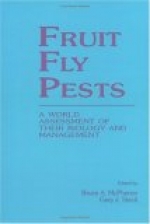Tab Article
A book of national and international importance, Fruit Fly Pests is an exhaustive compendium of information (with data provided by more than 100 contributors) that will appeal to a wide variety of readers. With huge losses experienced annually from fruit fly devastation, information on these high-profile insects is important to commercial fruit and vegetable growers, marketing exporters, government regulatory agencies, and the scientific community. Fruit flies impose a considerable resource tax, and the ones who suffer range from shippers to end users. The demand for world-wide plant protection requires up-to-date research information. This book meets that need.This book contains the proceedings from the most recent International Symposium on Fruit Flies of Economic Importance. Here you will find the major presentations given at the symposium, with an added feature - overviews from experts on topics not covered directly by participants in the symposium, filling in gaps in the current literature. The resulting publication is the most up-to-date and readable text to be found anywhere on the subject of tephritids.


